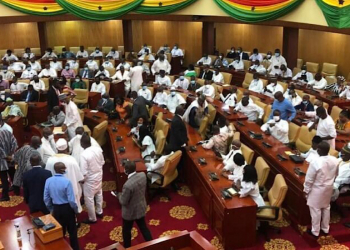Disaster looms at Ablekuma, Kasoa, Ofankor because of building on hills
Residents of some communities in Accra and Kasoa Tollbooth have been alerted to a possible landslide disaster, similar to the one that claimed the lives of more than 1,000 people in Freetown, Sierra Leone in August this year.
The Ghana Institution of Engineers (GhIE) gave the warning and said: “The circumstances that led to the Sierra Leonean situation are not different from what is happening today in Ghana around the Kasoa Tollbooth, Ablekuma, NIC and Ofankor all in the Greater Accra Region.”
Delivering the 48th Presidential Address of the institution in Accra last Thursday night, the President of the institution, Mrs Carlien Bou-Chedid, said human activities, including quarrying and construction, had affected the aforementioned areas to the extent that they had become vulnerable. She said a similar situation existed on the Sugar Loaf Mountain in Freetown, where the flooding occurred recently.
The GhIE presidential address, on the topic: “Sustainable development: an illusion without disaster risk management,” touched on a wide variety of issues, including flooding, tidal waves, challenges in the construction industry and earthquakes and their mitigation measures.
On the issue of buildings collapsing, the President of GhIE said buildings and other structures revealed similar problems, adding that when it came to the monitoring of those structures; building inspectors were often blamed when failures occurred
“A careful examination of the various incidents of such failures consistently reveals that failures have occurred because unqualified personnel have been engaged in design or construction and very often, both.
“The onus for ensuring that the right things are done must be put squarely in the hands of the developer.
“All structures must be designed and supervised by relevant engineering practitioners who must sign off at every critical stage and documentation must be maintained for periodic audits by the Engineering Council. Thus, for example, when the foundations are exposed, the relevant engineering practitioner must inspect and certify,” Mrs Bou-Chedid said.
The Daily Graphic of June 19, 2015, drew public attention to dangers at the Kasoa Tollbooth in a story in which the Deputy Director of the Geological Survey Department, Dr Thomas Kwasi Adu, raised red flags about a major catastrophe awaiting to happen in the area if the massive development going on in the settlement was not controlled.
In that publication, Dr Adu said given that the area was a highly prone earthquake zone, unpredictable rainfall patterns and days of continued rain could spell doom for communities at the edge of the mountain and, to some extent, those on top of it.
On a visit to the area, this paper saw a gaping hole from the quarrying activities from where volumes of water from the mountain wash down sediments onto the road whenever there is a heavy rainfall.
“ If it rains continuously and the mountain soaks so much, we can have a major landslide and all those buildings close to the mountain will end up in a disaster,” he said.
Dr Adu, who questioned the rationale behind issuing building permits for the construction of houses and churches in the area, said such development amounted to provoking nature.
“People building close to the hill should be checked. We have to learn from other countries. Anytime there is a landslide, the people who go first are those close to mountains.
“They should have left some buffer at the edge of the hills so that when it is flooded, the force will reduce by the time it gets to the permissible zone to reduce the impact.
“From that side to Nyanyanor is a major earthquake zone, so if you are on the zone and you have built close to a steep mountain, you are endangering your life,” he emphasised.
In the absence of proper drainage in the settlements, running water and mud from the hills create deep gullies and end up on the road.
Meanwhile, the development in the area is stripping the land of its vegetative cover.
Experts say the soil in the area is loose, making the area susceptible to erosion.
A section of the mountain, which became a major source of gravel for the construction of the Mallam-Kasoa road, has, over the years, been taken over by sand winners and people who make a living at a nearby quarry.
The area is not new to mudslides. In June 2013, loose parts of the mountain fell and blocked the Kasoa-Weija portion of the road after a downpour, resulting in a traffic jam for hours.
On June 14, 2015, a similar incident happened, causing a massive mudslide that took days to clear.
Apart from the houses competing for space, churches have also sprung up—the biggest among them being the Great Fire Pentecostal International Ministry, popularly known as Bonegas Church.
The church’s temporary structure, which has a capacity to accommodate more than 2,000 worshippers, sits less than 100 metres from the mountain.
With those scenarios probably in her mind, Mrs Bou-Chedid observed that man-made hazards such as soil degradation could often seem inconsequential in the grand scheme of things, especially when they were compared to natural disasters such as earthquakes or floods.
“Their significance is often only fully appreciated when they are involved in a multi-hazard event triggered by a natural disaster. The August 14, 2017 landslide in Sierra Leone was triggered following three days of torrential rains,” Mrs Bou-Chedid, the first female president of the GhIE, said.
According to the National Disaster Management Organisation (NADMO), there were also threats of landslides in all the regions of Ghana except the three northern ones.
The entire Afram Plains District and part of the Kwahu South District were cut off from the rest of the country as a result of a landslide at Kam, a village near Pitiku Junction in the Eastern Region, following a downpour.
The first landslide in the area occurred in 1972.
A downpour triggered a landslide on the Peduase-Water Works road, a stretch of the Pantang-Mamfe dual carriageway in the Eastern Region.
The landslide occurred close to a two-storey building on the edge of a rocky mountain, blocking part of the road.
A landslide that occurred during another downpour at Adukrom-Yensi in the Eastern Region killed three persons and destroyed many properties.
Twenty acres of cocoa farms were destroyed at Wassa Asikuma and Wassa Nkran in the Prestea / Huni Valley District in the Western Region following a heavy rainfall which affected 60 cocoa farmers.
Sign up for GhanaStar.com to receive daily email alerts of breaking news in Ghana. GhanaStar.com is your source for all Ghana News. Get the latest Ghana news, breaking news, sports, politics, entertainment and more about Ghana, Africa and beyond.




